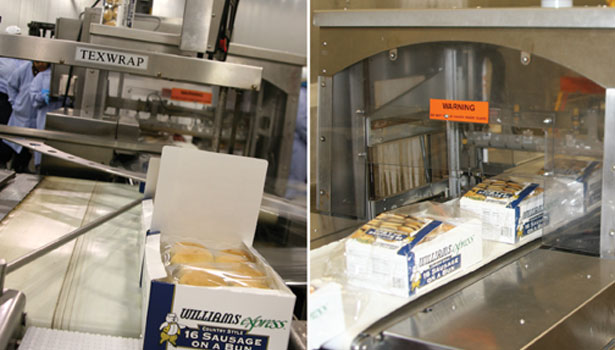System upgrade doubles throughput, maximizes line uptime and provides efficient long-term operational ROI.
Williams Sausage, founded by Harold and Hazel Williams in 1958 and located near Union City, TN, runs 11 packaging lines to handle different product types. Four lines are for packaging sausage links and chubs, and four others are for packaging sausage patties. Three lines are dedicated for packaging breakfast biscuit sandwiches, with one line specifically dedicated to jumbo sandwiches. To improve efficiency and accommodate increased throughput, the two remaining breakfast sandwich lines were redesigned to upgrade their shrinkwrap packaging capability.
These two lines allow for the manual assembly and packaging of sausage biscuits. When the sandwiches are being assembled, the biscuits are put through a cutter that slices them in half. The split biscuits move along a conveyor, where sausage patties are manually put between the two biscuit slices. These sandwiches then go through a wrapper, and the sealed biscuits are stacked into cartons. At this point, the two lines merge onto one packaging line, where the cartons are put through a shrinkwrapper, cased, labeled and palletized.
As with any growing business, there were challenges. “Our production volumes had significantly increased,” says Tommy Ray, plant manager at Williams Sausage. “But we needed to double our packaging capability, our throughput of cartons per minute, to keep up with the demand.
“The bottleneck was our shrinkwrapping system,” continues Ray. “The wrapper was only capable of handling 12 to 14 cartons per minute. But at this rate, we were experiencing line interruptions and delays. We needed to have the ability to shrinkwrap 24 to 28 cartons per minute to keep the sandwich manufacturing lines moving.”
The processor brought in Texwrap Packaging Systems to engineer a shrinkwrap system that would address the throughput and downtime issues. Aside from maintenance issues caused by heavy throughput volumes, the existing L-bar shrinkwrap machine was operating in a cold, damp environment, which caused several problems. The forming of ice crystals, for example, caused drive belts to slip or grab, affecting machine registration. The shrinkwrapper compensated for this by making a longer film bag than necessary, costing more money for film and using more heat energy as well. In addition, the L-bar architecture required running cartons of the same size through the wrapper; otherwise, the machine had to be stopped for changeover to a different carton size.
Williams installed a Texwrap Model 2202 CR continuous-motion, side-seal wrapper with Motion Trim, Speed Maximizer and Auto-Spacing technologies. With this wrapper, the incoming stream of product does not stop while the end seal is being made, thereby increasing throughput speed.
With Auto-Spacing control and the ability to vary the conveyor speeds to relax the film between products, the new shrinkwrapping system accommodates randomly fed cartons and accurately separates them for reliable, consistent packaging using the absolute minimum amount of film.
For more information: Tom Dickman, 636-239-7424, tomd@texwrap.com

